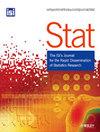Bitcoin Price Prediction Using Deep Bayesian LSTM With Uncertainty Quantification: A Monte Carlo Dropout–Based Approach
IF 0.8
4区 数学
Q3 STATISTICS & PROBABILITY
引用次数: 0
Abstract
Bitcoin, being one of the most triumphant cryptocurrencies, is gaining increasing popularity online and is being used in a variety of transactions. Recently, research on Bitcoin price predictions is receiving more attention, and researchers have investigated the various state‐of‐the‐art machine learning (ML) and deep learning (DL) models to predict Bitcoin price. However, despite these models providing promising predictions, they consistently exhibit uncertainty, which cannot be adequately quantified by classical ML models alone. Motivated by the enormous success of applying Bayesian approaches in several disciplines of ML and DL, this study aims to use Bayesian methods alongside Long Short‐Term Memory (LSTM) to predict the closing Bitcoin price and consequently measure the uncertainty of the prediction model. Specifically, we adopted the Monte Carlo dropout (MC‐Dropout) method with the Bayesian LSTM model to quantify the epistemic uncertainty of the model's predictions and provided confidence intervals for the predicted outputs. Experimental results showed that the proposed model is efficient and outperforms other state‐of‐the‐art models in terms of root mean square error (RMSE), mean absolute error (MAE) and使用具有不确定性量化的深度贝叶斯 LSTM 预测比特币价格:基于蒙特卡罗剔除的方法
比特币作为最成功的加密货币之一,在网上越来越受欢迎,并被用于各种交易。最近,有关比特币价格预测的研究受到越来越多的关注,研究人员研究了各种最先进的机器学习(ML)和深度学习(DL)模型来预测比特币价格。然而,尽管这些模型提供了有前景的预测,但它们始终表现出不确定性,而这种不确定性仅靠经典的 ML 模型是无法充分量化的。贝叶斯方法在多个 ML 和 DL 学科中的应用取得了巨大成功,受此激励,本研究旨在使用贝叶斯方法和长短期记忆(LSTM)来预测比特币收盘价格,从而测量预测模型的不确定性。具体而言,我们采用蒙特卡罗剔除(MC-Dropout)方法与贝叶斯 LSTM 模型相结合,量化模型预测的认识不确定性,并提供预测输出的置信区间。实验结果表明,所提出的模型是高效的,在均方根误差(RMSE)、平均绝对误差(MAE)和 R2 方面都优于其他最先进的模型。因此,我们相信这些模型可以帮助投资者和交易者根据比特币价格的短期预测做出关键决策。本研究说明了在时间序列分析中利用贝叶斯 DL 方法提高数据预测准确性和可靠性的潜在好处。
本文章由计算机程序翻译,如有差异,请以英文原文为准。
求助全文
约1分钟内获得全文
求助全文
来源期刊

Stat
Decision Sciences-Statistics, Probability and Uncertainty
CiteScore
1.10
自引率
0.00%
发文量
85
期刊介绍:
Stat is an innovative electronic journal for the rapid publication of novel and topical research results, publishing compact articles of the highest quality in all areas of statistical endeavour. Its purpose is to provide a means of rapid sharing of important new theoretical, methodological and applied research. Stat is a joint venture between the International Statistical Institute and Wiley-Blackwell.
Stat is characterised by:
• Speed - a high-quality review process that aims to reach a decision within 20 days of submission.
• Concision - a maximum article length of 10 pages of text, not including references.
• Supporting materials - inclusion of electronic supporting materials including graphs, video, software, data and images.
• Scope - addresses all areas of statistics and interdisciplinary areas.
Stat is a scientific journal for the international community of statisticians and researchers and practitioners in allied quantitative disciplines.
 求助内容:
求助内容: 应助结果提醒方式:
应助结果提醒方式:


